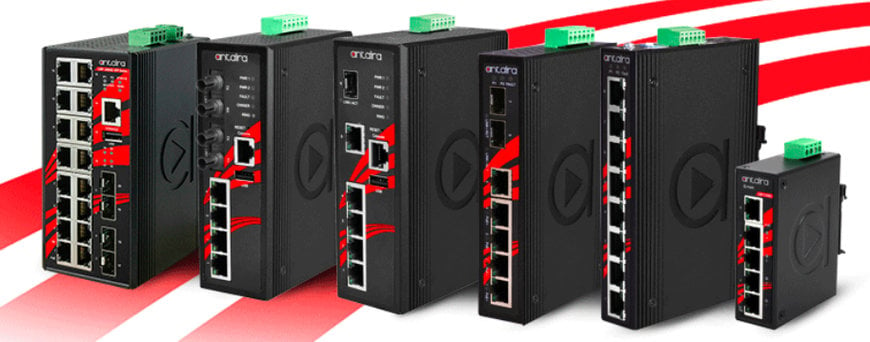What Really is an Industrial Managed Switch?
Article by Henry Martel, Field Applications Engineer, Antaira Technologies.

In this article we identify the attributes of a high-quality industrial managed switch. Before we do that, however, we need to first clarify what makes an environment "industrial". For our purposes, we define an industrial environment as any workplace that exerts extreme physical stress on networking equipment.
These stresses may involve exposure to moisture and humidity, dust or other airborne contaminants, corrosive chemicals, high or low temperatures, oil and grease splatter, strong vibrations, heavy impact, and poor power quality, among others. Now that we’ve established the “industrial” part of the equation, let’s drill down into what a managed switch is and identify the key components that enable it to perform.
Put simply, an industrial switch connects devices within a common network and transmits Ethernet data frames to and from those devices. Ethernet switches enable users, devices and applications to communicate with each other and share resources. Unlike a router, an Ethernet switch only sends data to a specific destination client, such as another switch, an IP camera, or a PC.
Once a device is connected to a network switch via an Ethernet cable, the industrial network switch records the device’s Media Access Control address (MAC) located on the Network Interface Card (NIC). The industrial Ethernet switch then uses the MAC address to pinpoint which location the device’s outgoing packets are being sent, and where to deliver incoming packets.
Industrial Ethernet switches can be either managed switches or unmanaged switches. Managed switches have more capabilities than unmanaged switches, and let administrators adjust each port to its own individual settings for better network management, configuration and monitoring. A managed switch will also provide more granular control over how data packets travel and who can access the data which is critical to optimal traffic management and security.
Industrial Components
Inside a managed switch housing are interconnected components working together. Poor component quality will lead to malfunctions, failures, and loss of productivity while the IT staff struggles to diagnose the problem. Choosing an industrial managed switch built with robust components — like those found in Antaira’s broad portfolio of managed switches, makes it far less likely that it will fail in a critical application.
The primary components of an industrial managed switch are:
- Processor: The processor is the "brain" of the switch and is responsible for executing the instructions that control the switch's behavior and function. It is responsible for managing the switch's operations, such as forwarding packets and maintaining the switch's forwarding table.
- Memory: The switch's memory is used to store the operating system, configuration data, and other information that is needed by the switch to operate.
- Network interface controllers (NICs): The NICs are the physical connectors or ports that the switch uses to connect to the network. These ports can be Ethernet ports or other types of connectors or ports such as serial ports or USB ports.
- Switch fabric: The switch fabric is the part of the copper fiber on the switch that is responsible for forwarding data packets between the different ports on fiber on the switch.
- Management interface: The management interface is the part of the switch that allows administrators to configure and manage the switch remotely, using a web-based interface or specialized software.
- Power supply: The switch's power supply provides the electrical power needed to operate the switch. Industrial Ethernet switches are often specifically designed for to operate using a wide range of voltage levels and may have redundant power supply supplies to improve reliability.
Managed Switches Functionality
As the use of Ethernet devices has accelerated in industrial applications, requirements such as cybersecurity, segment isolation network redundancy, and packet priority control have made industrial unmanaged switches increasingly impractical solutions. Numerous features distinguish industrial managed switches from unmanaged models that ensure the industry the highest network availability.
Quality of Service (QoS): QoS allows the switch to prioritize certain types of traffic, such as real-time data transmission or voice communications, over less critical traffic by applying a tag to data transmission as a higher priority packet. This helps to ensure that the network remains responsive and reliable. A fast, reliable network is key to keeping a business running smoothly and paving the way for growth.
Virtual Local Area Networks (VLANs): VLANs allow the switch to segment the network into separate logical subnets, which can be useful for security or organizational purposes. Access is controlled by the switch to the various VLAN subnets. It also gives devices and switches that need to communicate to each other maximum bandwidth. VLANs are a logical way to separate networks through software instead of physically relocating devices, switches, or connections.
Security features: Managed industrial Ethernet switches often include support for advanced security features such as access control lists (ACLs), virtual private network (VPN) support, and support for network intrusion detection/prevention systems (IDS/IPS).
Simple Network Management Protocol (SNMP): Managed industrial switches use this internet standard protocol to monitor and manage connected network devices. It will detect and correct network problems while also collecting network statistics for administrators to analyze and can determine what action needs to be taken to make your network perform with greater resiliency and security.
Remote management: Managed industrial switches can typically be configured and managed remotely using a web-based interface or specialized software solutions. This allows for more integration, easier deployment, and troubleshooting of the network for faster issue resolution. Advanced reporting and monitoring: Managed industrial switches often include network redundancy and advanced reporting and monitoring capabilities that allow administrators to track network performance, identify potential issues, and troubleshoot problems.
Disruptive technology in the form of Industry 4.0 first brought industrial switches onto plant floors several decades ago. The first-generation switches did not hold up well, failing often and requiring frequent maintenance. Since then, industrial-managed switches have only gotten stronger with hardened packaging featuring extended IP (ingress protection), temperature, shock, vibration, and surge ratings.
www.antaira.com

